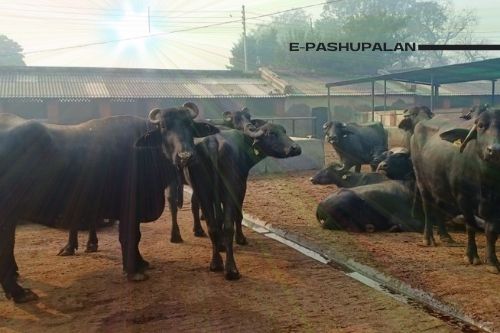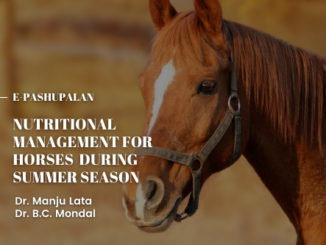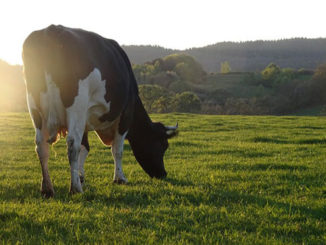Abstract
Heat stress (HS) is a multi-factorial problem that has adverse impacts on health and productivity of livestock and is closely related with animal welfare. Heat stress may not be harmful when animals are able to adapt themselves to the concerned conditions.
Measures dealing with minimizing summer stress are concerned mainly with heat loss/heat production balance. Generally livestock those are health compromised and high yielders are at higher risks of being affected by summer stress. , thereby requiring the most attention. Appropriate actions include: shade, sprinkling, air movement, optimum ventilation, feeding strategies in accordance with stress management and active cooling. So pro active stress management strategies utilizes these aspects : prior information, making a strategic to combat it , observing and recognizing affected animals and finally taking tactile actions.
Keywords: Summer stress, management strategy, stress assessment, temperature, heat stress alleviation, heat loss, nutrition, genetic selection.
Introduction
Stress is any condition that affects biological mechanisms of the body of animals. When there is any disturbance in equilibrium of body heat production and heat loss leading to increase in heat production and Stress is any condition that affects biological mechanisms of the body of animals. When there is any disturbance in equilibrium of body heat generation and heat loss leading to increase in heat generation and decrease in heat loss ,it results in onset of heat stress. Summer stress is the heat stress which is experienced by the livestock during
2-3 months of higher temperatures in summers. When heat load becomes much more for adaptive responses to compensate there results subsequent reduction in productivity, well being of livestock and in severe cases even mortality.

Effects of summer stress
- Heat stress is directly reflected by rise in pulse rate with weaker pulse.
- Physiological Body parameters of animals are affected like summer stress leads to rise in rectal temperature, respiratory rate, heart rate.
- As temperature reaches 106- 107 ° F then there occurs heat stroke leading to unconsciousness, dizziness, dry body condition.
- There is dehydration which results in sunken eye balls, and animal may even fall down suddenly.
- Weakness , loss of drought power in bullocks , less libido in bullocks, lower reproduction of the females due to early embryonic death.
- Fall in milk production and quality is deteriorated.
- Chances of disease prevalence increases, tick infestations is at peak in summers causing high incidence of haemoprotozoal diseases like babesiosis and theileriosis.
Differential Susceptibility of animals to summer stress
Indigenous or desi breeds are more thermo-tolerant in comparison to exotic breeds which are more prone to stress. Buffaloes are more susceptible or are affected to greater extents with heat stress because of their darker skin coat which absorbs more solar radiation and also they are having less sweat glands which leads to improper heat dissipation contributing to summer stress. Calves and older animals are more susceptible to heat stress. Horses having abundant sweat pores are less susceptible.
Factors For Summer Stress Assessment Of Livestock
- Temperature is the main factor responsible for causing summer stress in livestock. There is a thermoneutral zone for animals in which they feels most comfortable which varies 15-25 degree Fahrenheit for cross bred cattle and 15-28 degree F for indigenous cattle.
- Recommended Relative humidity in animal houses for cattle is between 60% to 70%. It should be maintained properly for better performance and production of animals and also to counterbalance summer stress.
- Temperature humidity index (THI) is the measure of atmospheric temperature and relative humidity in a single value and also known as ‘ discomfort index’. It is one of the best methods for assessing heat stress of animals. High producing animals experiences no heat stress when temperature humidity index is less than 72 while severe stress when temperature humidity index exceeds 88.

Strategies to alleviate summer stress in livestock
Animals in temperate countries experiences summer stress during 2-3 summer months that can be tackled via short term changes in physiological, behavioral and immunological functions in contrast to tropical conditions where animals are heat challenged most of the time. Heat loss by water evaporation is very efficient way of heat transfer to the hot environment which can occur through skin or respiratory evaporative loss.
1) Alteration in surrounding Environment
Reduction in thermal stress can be brought about by alteration in animal housing related facilities like shape, orientation, construction materials, ventilation etc. two methods responsible for bringing about these change are:
By reducing heat stress
These environmental alterations minimizes the heat stress by reducing both radiations from sun or ambient temperature in the vicinity of the animal. This can be achieved by :
- Providing proper shade either natural or artificial due to which animals are protected from solar radiations and there is provision of cooling effect. Animals kept in shaded areas shows improved milk production and reproduction as well as reduction in rectal temperature and respiratory rate.
- Various roofing designs like reflecting roofs like galvanized and aluminum roofs also helps in reducing heat stress .
- Evaporative Cooling systems leads to summer stress minimization. It can be attained by fogging systems, misting systems and cooling pads.
- Foggers utilizes water in the form of tiny droplets by use of high pressure nozzles so as to enhance contact of water surface with air as water is completely evaporated fogging system doesn’t leads to wastage of
- Misting systems generates droplets of greater size as compared to fogging systems but cools the air by exactly similar principle. In case of high humidity large water droplets causes wetting of the bedding and the feed. Misters under the shades in the loafing areas should be used in conjunction with the fans , at 8 -9 feet above and oriented down at 30 degrees.
- Pad and fan cooling systems can also be used in which surrounding hot air inside the building when it passes through the wet pad.
- Wallowing in the wallowing tanks is the least laborious and most easy tool to combat summer stress in buffaloes.
- Wet gunny bags can be tied in the animal shed in peak sunny hours.
By enhancing animal heat losses
Heat loss is mainly achieved various mechanisms
- Improving natural ventilation is a key tool in alleviating summer stress which can be achieved by a constructing buildings having proper orientation and are semi-opened along with high roofs which are isolated (Holik, 2009). Additional fans can also be installed..
- Airflow along with adding water on skin coat enhances the evaporation rate of additional water. Water evaporation accompanies heat being absorbed from body of animal and surrounding air. drippers or sprinklers are used for applying water on coat. These systems have wide applications in pig production for minimizing thermal stress and holds higher performance rates in comparison to other methods. (Nichols et al. ,1979). Sprinkler systems used in dairy cattle resulted in enhanced milk production, improved reproduction and improved conversion of feed to milk.
2) Alterations in feeds and Feeding strategies
Many feeding strategies have been used for lowering down harmful effects of summer stress. The main aim is to maintain water balance, intake of nutrients and electrolytes and to look for supplying vitamins and minerals during heat stress.
Changes in macro nutrients composition
Animals under summer stress/heat stress have reduction in feed intake which is a adaptation to minimize metabolic heat production. Two main nutritional strategies are followed , one is by making use of energy or protein concentrate diets to overcome the low dry matter intake and other is using low increment diets which improves dry matter intake. Heat increment on utilizing crude proteins or fiber is higher than for starch or fat. energy content of the diet is enhanced via lipid addition which can partially overcome the effect of heat stress.
Changes in micronutrient composition
Sweating and panting because of heat stress leads to acid base balance to get disturbed which can be rectified by proper mineral supplementation. (collier et al . 2006 ). Heat stress also induces oxidative injuries which can be minimized by supplementing vitamins. Due to sweating and hyper ventilation blood acid -base balance is disturbed from normal leading to respiratory alkalosis. In heat stressed cows reduced concentration of blood bicarbonate as a result of respiratory alkalosis is directly reflected in compromised rumen buffering capacity. Reduced feed intake along with reduced buffering capacity of animals contributes to greater potential for rumen acidosis during heat stress so dietary buffers needs to be added in heat stressed cows in summers. (sanchez et al. , 1994)
Alterations in Feeding strategies
Grazing cattle’s are allowed to feed in rasher periods of day like 6-10 AM in the morning and 5-7 in the evening hours so that exposure of sunlight in peak hours is avoided leading to enhanced ability of animal to combat with heat stress. Provision of fresh feed through multiple frequency of feeding. (Holt et al ., 2004; Mader and Davis, 2004).
3) Water management
Water plays a very important role as a nutrient for livestock during thermal stress hours in summers. Water intake during heat stress is ultimate important factor in survivability and performance as water is required in heat exchange systems for temperature regulation and maintenance of hydration balance. Water losses through panting and sweating are more during hot summer season so water intake needs to enhanced to meet the requirements of a heat stressed animal.
4) Genetic selection
Individual species/breed and individuals within species/ breed varies considerably in terms of heat tolerance. In tropical areas, emergence of breeds which are more thermo tolerant has been made possible due to natural selection The high heat tolerance of tropical local breeds is generally due to their smaller size, their lower productivity, skin coat, hairs, special designed appendages in comparison to commercial lines. Production potential of indigenous tropical breeds is lower but in case of summer stress by use of these indigenous Breeds only productivity can be improved to greater levels (Renaudeau et al ., 2007). However, in very harsh conditions animals can be made to adapt to climatic stress either by selection in stressful conditions or by introducing ‘heat adaptation genes’ from local breed in to a commercial breed. In cattle slick hair coat plays important role in heat tolerance. Some new technologies like high density single nucleotide polymorphism (SNP) panels are now a tool of choice for identification of complex traits like heat tolerance.
Conclusion
Heat stress negatively affects livestock performance in tropical as well as in temperate countries during summers which ultimately leads to economic losses. Summer stress affects growth, health, well being, production , reproduction of livestock which is a matter of great concern. Implementation of newly and scientific methods to minimize negative effects of heat are proper cooling system, ration adjustments, stress depletion will improve the health conditions of animals and ultimately economic conditions of dairy farms.
Reference
- Holik V 2009. Management of laying hens to minimize heat stress. Lohmann Information 44, 16–29
- Nichols DA, Ames DR and Hines RH 1979. Evaporative cooling systems for swine. Report of Progress, Agricultural Experiment Station, Kansas State University, pp. 6–9.
- Collier RJ, Dahl GE and VanBaale MJ 2006. Major advances associated with environmental effects on dairy cattle. Journal of Dairy Science 89, 1244–1253
- Sanchez WK, McGuire MA and Beede DK 1994. Macromineral nutrition by heat stress interactions in dairy cattle: review and original research. Journal of Dairy Science 77, 2051–2079.
- Holt SM, Gaughan JB and Mader TL 2004. Feeding strategies for grain-fed cattle in a hot environment. Australian Journal of Agricultural Research 55, 719–725.
- Mader TL and Davis MS 2004. Effect of management strategies on reducing heat stress of feedlot cattle: feed and water intake. Journal of Animal Science 82, 3077–3087
- Renaudeau D, Huc E and Noblet J 2007. Acclimation to high ambient temperature in Large White and Caribbean Creole growing pigs. Journal of Animal Science 85, 779–790






Be the first to comment